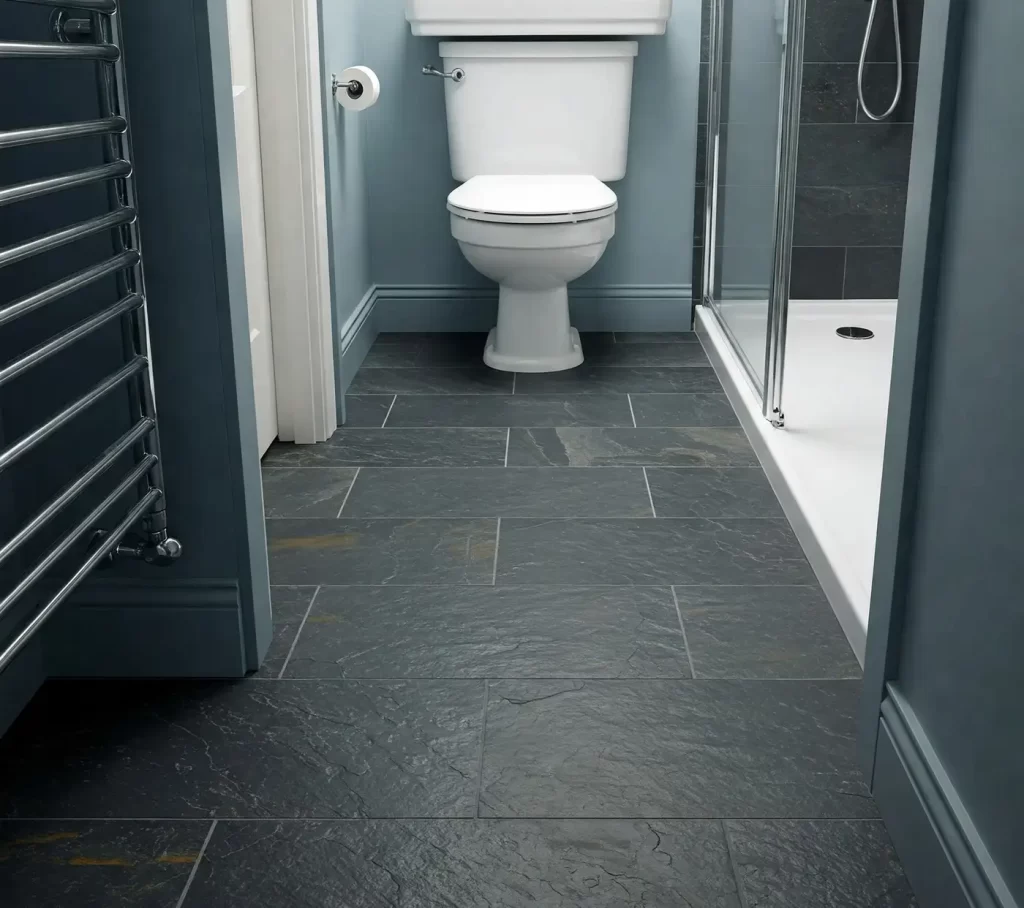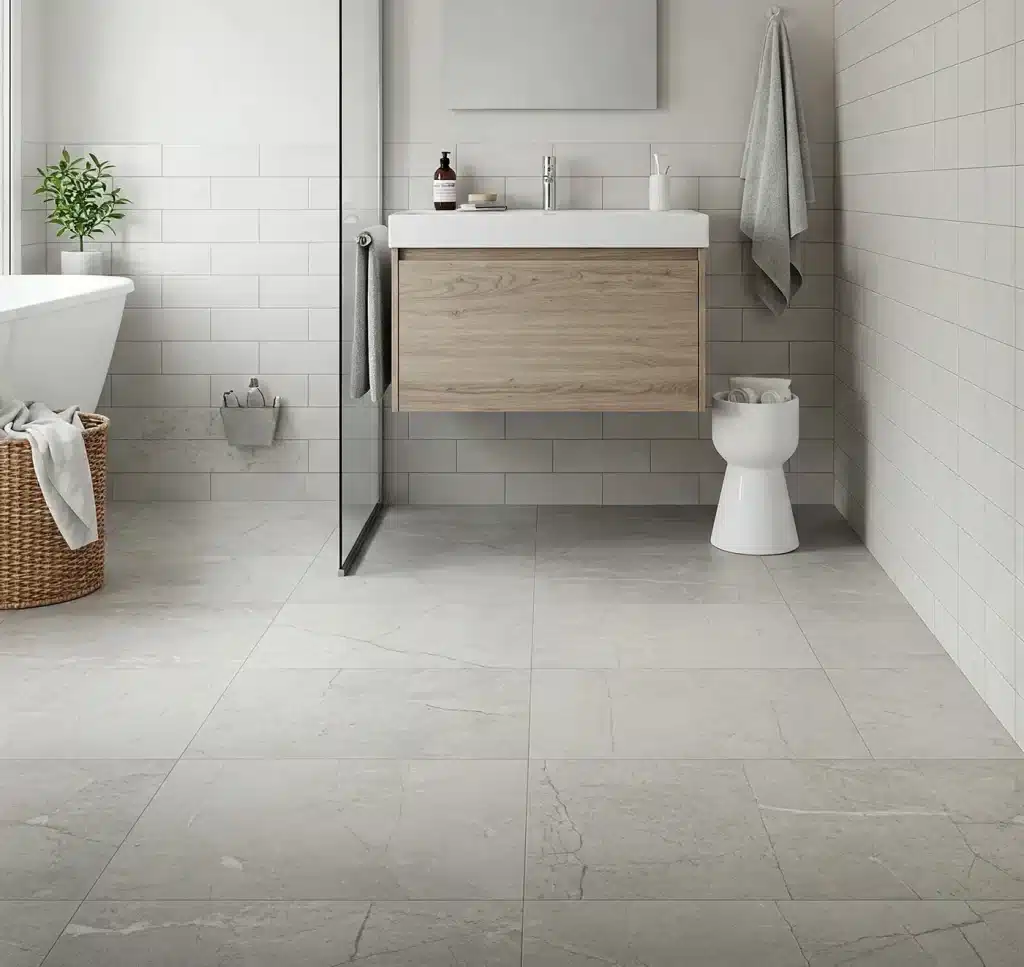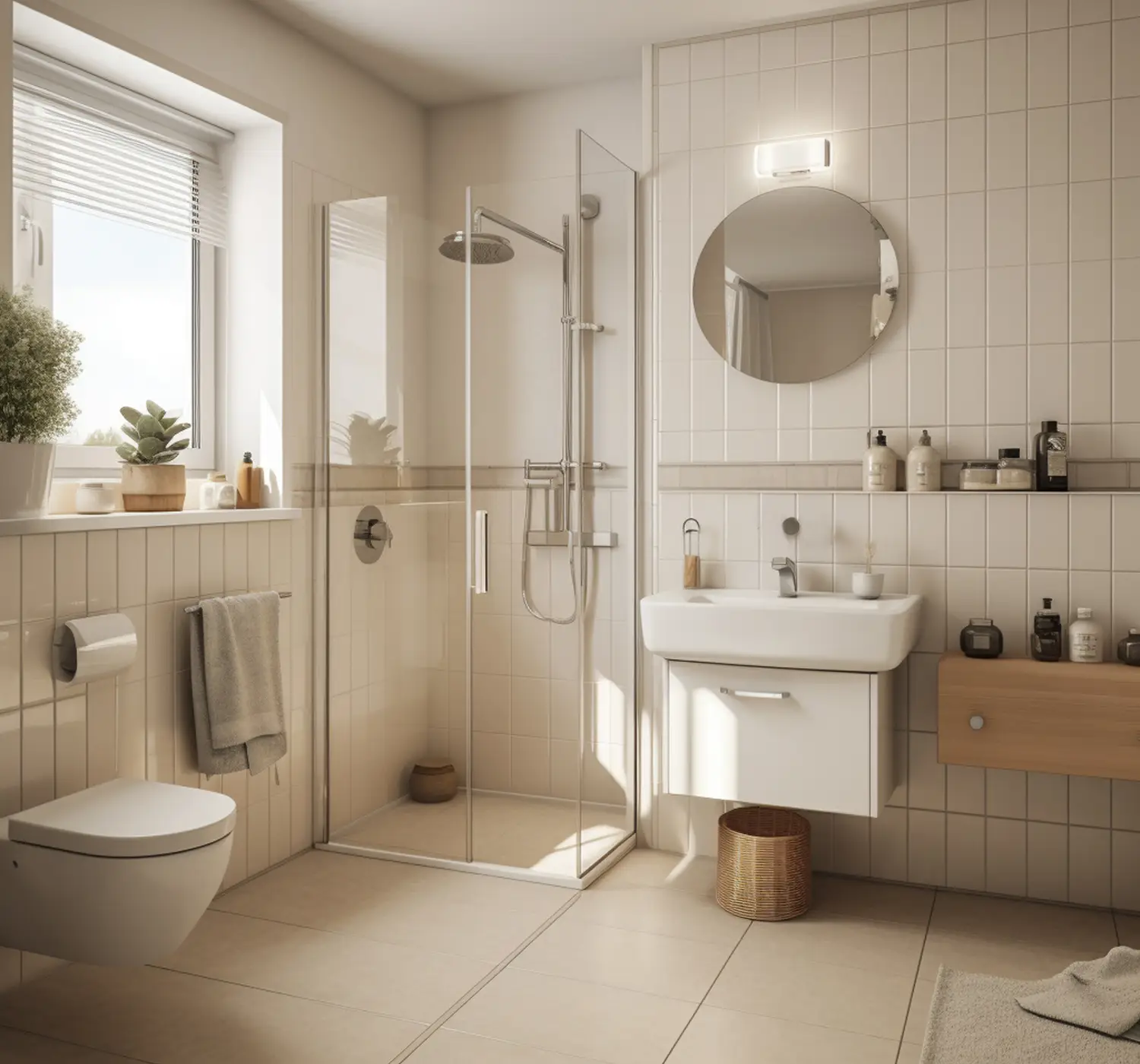Small bathrooms have a way of making you hyper-aware of every square inch. One wrong tile or poorly chosen finish, and suddenly, it feels more like a utility closet than a place you’d want to unwind with a hot shower.
Choosing the right flooring can transform that tight space into something that actually feels good to walk into. Flooring is one of the core bathroom design ideas that can completely change the feel of a small space. So, what is the best flooring for a small bathroom? Let’s dig in.
What is the best flooring for a small bathroom overall?
If we’re talking an all-round winner, the one that balances performance, practicality, and aesthetics—luxury vinyl tile (LVT) usually tops the list.
Why? Because it can do what most small-bathroom floors need to do: survive splashes, handle humidity, and look pretty great while doing it. It’s waterproof, warm underfoot, and comes in designs that look like stone or wood—but without the price tag or upkeep.
And unlike big, clunky tiles that can make a small bathroom feel even tighter, LVT tends to have that soft visual footprint. Clean lines. No grout. Easy to clean. No panic when the kids dump half the bathwater on it.
It’s the kind of flooring that works hard without making a fuss. Especially in UK homes where bathroom space often feels like an afterthought.
Of course, porcelain tile deserves a shout-out. It’s durable, water-resistant, and has that classic bathroom look. But it’s colder, harder, and usually means a bit more spending—especially if you add underfloor heating (which you might want to, unless you love stepping onto a chilly floor first thing in the morning).
In a nutshell: If you want low-fuss, great-looking, and water-tough flooring—go LVT. If you’re after high-end, timeless, and don’t mind the extra effort—go porcelain.
Best flooring for a small bathroom in terms of durability

Let’s talk about the stuff that survives. Because in a small bathroom, everything gets tested—daily. Think morning routines, muddy shoes, teenage hair products, or the occasional toothpaste explosion. Your floor needs to be ready for all of it.
So knowing what is the best flooring for a small bathroom in terms of durability is no less important than aesthetics and convenience.
Porcelain and ceramic tiles are the clear winners here. Here is why:
✓ They don’t scratch easily, don’t dent, and they’ll look practically new five years from now—if you don’t mind the occasional deep clean of the grout.
✓ They’re baked at high temperatures, making them hard-wearing and water-resistant.
✓ They resist scratches, shrug off moisture, and don’t flinch when you drop your shampoo bottle on them.
✓ They also don’t warp or stain, which means it holds up beautifully in damp, high-use spaces—like your small bathroom, where everything’s a bit more concentrated.
Now, if tiles aren’t your vibe, LVT comes in a close second. It doesn’t crack like ceramic, won’t absorb water, and is way more forgiving if you drop something heavy. It won’t last forever, but for most UK homes, it’s durable enough to do the job.
Natural stone like slate or travertine might look durable—and it is—but it’s high maintenance. It needs sealing, and it can be prone to staining or etching if you’re not careful with what you drop. Gorgeous, yes. Fuss-free, not quite.
Sheet vinyl also deserves a quick nod here. It’s seamless (aka no grout lines), waterproof, and pretty hard to mess up. It might not last as long as tiles, but if you’re on a budget or renovating a rental, it’s a smart pick.
So, if durability is the hill you’re willing to stand on—porcelain and ceramic tiles are your best mate. They’re built to take the hits; they are like heavy-duty boots of bathroom flooring.
However, before choosing them, make sure you are okay with the extra installation effort.
Best non-slip flooring for small bathrooms

If you’ve ever done the awkward mid-shower slip-and-slide, you’ll know—non-slip flooring in a small bathroom isn’t optional.
When you’ve got limited space, there’s less room to recover from a stumble. One misstep and you’re forehead-to-toilet in record time. Not ideal.
So, what is the best flooring for a small bathroom that will keep you steady?
Textured porcelain tiles top the safety chart. Look for tiles with an R rating—R10 or above if you’re playing it safe. These tiles are designed with a slightly rougher surface that adds traction, even when wet. Less ballet, more grip.
In general, matte finishes work better than glossy ones, and anything with a stone-like texture tends to have more grip underfoot.
Another great option? Non-slip vinyl flooring. Some LVT ranges and sheet vinyl options are specifically designed with safety in mind—especially useful if you’ve got kids running in and out, or older family members who need a bit more stability.
If you’re after something soft and safe, rubber flooring is another wildcard pick. It’s naturally non-slip, cushioned underfoot, and surprisingly stylish when done right—although it’s less common in residential bathrooms, and a little pricier.
But it is important to note even the best non-slip flooring can get slippery with soap or conditioner spills. So, think of layout, drainage, and the occasional bath mat as part of the safety package.
Also, don’t assume water-resistant means safe. Non-slip flooring is its own thing. And in small bathrooms, it’s one of the most practical upgrades you can make.
Best flooring for an aesthetically pleasing small bathroom

Looks matter. Especially in a small bathroom where every detail is right there. However, some bathrooms feel like a rushed afterthought.
Wrong tiles, weird colour choices, flooring that clashes with everything else. It doesn’t take much to make a small space feel… off.
If your goal is to make that tight little room look sharp, stylish, and not like something out of a landlord’s leftover tile box—your flooring needs to pull its weight.
So, what are the best flooring options for a small bathroom that will make it stunning?
Large-format porcelain tiles can look great in small bathrooms. Especially in light neutral tones—think soft greys, creamy beige, or pale stone. They create a sleek, clean surface that visually expands the room. Less grout = less clutter for the eyes.
If you’re going for that warm, Scandi-inspired vibe, wood-look LVT can be a game-changer. It gives you the beauty of natural timber without the swelling, warping, and moisture issues. Pair it with white walls and a floating vanity, and it’s minimalism done right.
For something bold? Patterned vinyl flooring is making a comeback. Think Victorian-inspired designs or subtle geometric prints that add a splash of personality without swallowing the room.
Especially effective in older UK homes where a bit of character fits right in.
And don’t forget flooring that feels good. Matte finishes often look more sophisticated than shiny ones, especially under artificial lighting. They also photograph better—just saying.
So, if you’re aiming for wow without sacrificing function—go visual. Go for clean lines, soft tones, and textures that look expensive (even if they’re not).
But don’t cram too many trends into one floor. Let the flooring support the room, not fight with it.
Making a small bathroom look spacious with the right flooring

You can’t knock out walls. But you can fake a bit of space with smart flooring.
This is where design does some heavy lifting. Small bathrooms don’t need big changes—they need clever ones.
Here’s how to cheat the eye a bit:
→ Go light. Pale tones reflect more light and make the room feel airier. Whites, soft greys, and beiges are solid go-tos. Dark flooring can work, but only if the rest of the space is kept ultra-light and minimal.
→ Stick to large tiles or wide planks. It sounds backwards, but bigger flooring pieces in a small room = fewer lines = less visual clutter. Tiny tiles or busy patterns can make the room feel more cramped, especially if there’s already a lot going on (hello, shower screens and radiator pipes).
→ Lay flooring diagonally or in a herringbone pattern if you’re feeling bold. It draws the eye outward, across the room, instead of straight down the narrowest path.
→ Keep it consistent. If you can use the same flooring from the bathroom in a hallway or adjacent room, it creates flow and makes everything feel more connected—and less boxed in.
So, what’s the best flooring for a small bathroom if you want to fake a bit more square footage?
Go for light-coloured LVT, large matte porcelain tiles, or continuous sheet vinyl—and let your floor do the magic.
How to choose the best flooring for your small bathroom
Here’s the not-so-secret truth: there’s no single “best” bathroom floor for small bathrooms.
There’s only the best one for you.
And figuring that out comes down to asking the right questions—before you order 5 boxes of tiles and a matching grout, you’ll end up regretting during bathroom installation.
→ Start with use. Who’s using the bathroom? Is it the main family bathroom? A guest loo? A rarely touched en-suite? A kid-friendly space might need something more forgiving (and slip-resistant). A grown-up en-suite? You’ve got more freedom to focus on style.
→ Think about moisture. All bathroom floors need to deal with water. But not all do it equally. Vinyl and porcelain handle it best. Wood and laminate? High risk unless they’re specifically designed for wet areas—and even then, it’s a bit of a gamble.
→ Consider comfort. Porcelain looks great but feels cold. Vinyl? Warm and soft, but maybe not as high-end. Underfloor heating can balance this out if you’ve got the budget. No one loves stepping onto a freezing cold tile at 6am in December.
→ Match your style. Do you like a clean, modern look? Rustic warmth? Something vintage? Flooring sets the tone, and in a small bathroom, there’s nowhere for bad choices to hide. Choose a floor that fits you, not the trend of the month.
→ And finally—know your budget. That dreamy Carrara marble tile might look great on Pinterest, but sheet vinyl or LVT can pull off a similar look for a fraction of the cost. Spend where it counts. Save where it doesn’t.
Especially during a bathroom renovation, these careful choices will determine how happy you are with the space years down the line.
So, if you are asking how to choose the best flooring for your small bathroom, ask better questions and get better flooring. Simple.
In conclusion
Small bathrooms might not give you much space to play with—but the floor? That’s where you’ve got real influence.
Pick the wrong one, and everything will feel tight, cold, or awkward. Pick the right one, and the room will open up. It feels cleaner. Lighter. More yours.
So, what is the best flooring for a small bathroom?
That depends on what you value most—style, comfort, safety, durability, or a mix of all four.
But the good news? You’ve got options. Really good ones. And once you’ve found the right fit, it’s one of those small changes that makes the whole room look better, feel better and work better.
And isn’t that the point?
FAQ on Choosing the Best Flooring for Small Bathrooms
What flooring is most waterproof for a small bathroom?
Luxury vinyl tile (LVT) and sheet vinyl are 100% waterproof and perfect for high-moisture spaces.
Can I use wood flooring in a small bathroom?
Not traditional wood, but wood-look LVT or waterproof laminate can give the same effect without the risk.
What’s the safest flooring for a small bathroom?
Textured porcelain tiles or anti-slip vinyl are both solid choices for reducing slips.
What colour flooring makes a small bathroom look bigger?
Light shades—like soft grey, beige, or off-white—help reflect light and open up the space.
Can I use the same flooring in the hallway and bathroom?
Yes—especially with LVT. It creates visual flow and makes both spaces feel more connected.
What is the easiest flooring to clean in a small bathroom?
LVT or sheet vinyl—both wipe clean and don’t need grout scrubbing.
Can you use laminate flooring in a bathroom?
Only if it’s a waterproof version. Standard laminate won’t survive the moisture.
Best budget-friendly flooring for small bathrooms?
Sheet vinyl—cost-effective, waterproof, and comes in tons of designs.




